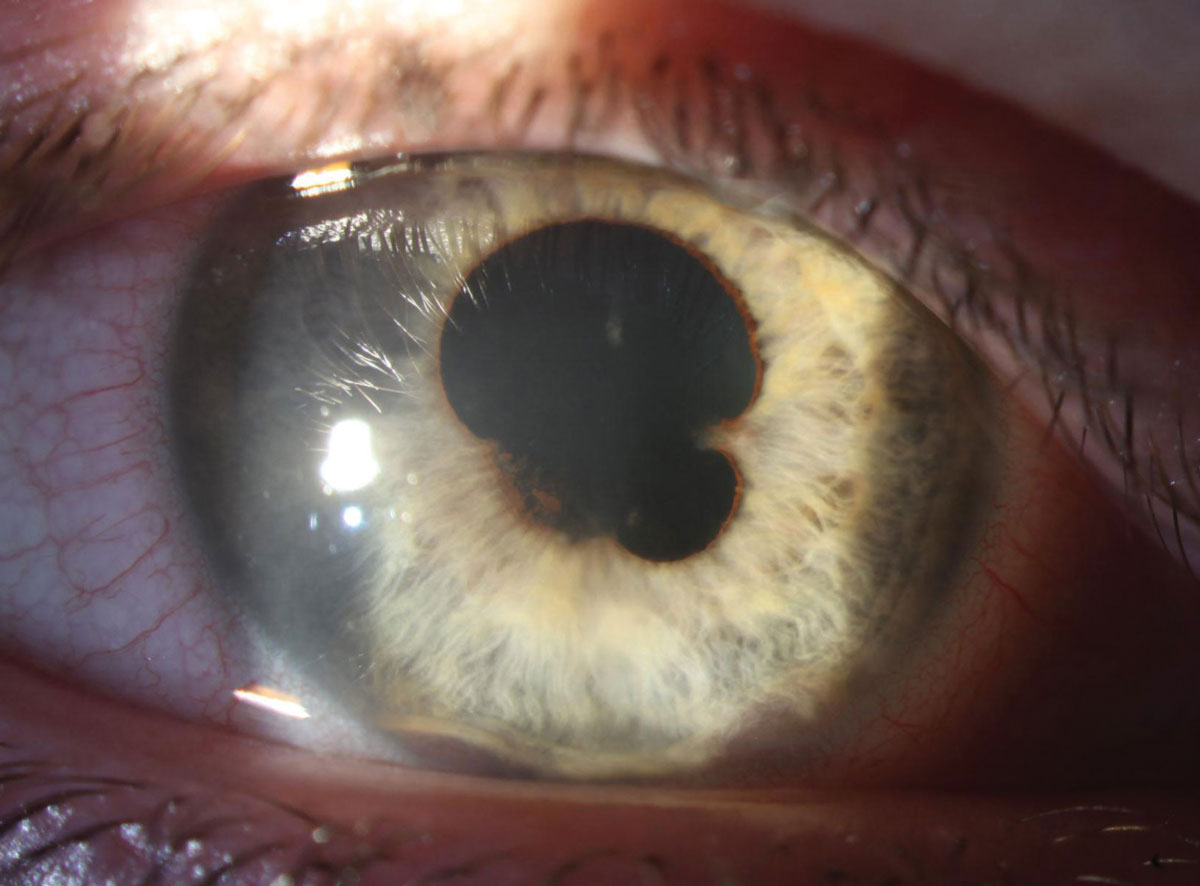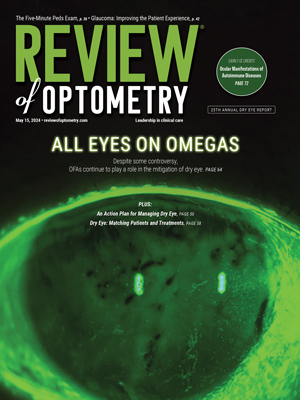The deployment of COVID-19 vaccines across the world made an undeniable positive impact on the spread and severity of symptoms, yet the further we get from that initial rollout, the more we’re learning about the vaccines’ short- and long-term effects in special patient populations. Although rare, ocular adverse events have been reported, including facial nerve palsy, uveitis and retinal vascular occlusion. Further research is warranted to determine if these events could be associated with other factors, and if vaccine type or dosing are contributing factors.
 |
| A study published in JAMA Ophthalmology investigated nearly 500,000 South Korean patients with a history of uveitis and a record of COVID-19 vaccination and found an increased risk of disease recurrence, especially in the time period between the first and second dose. Photo: Aaron Bronner, OD, and Alison Bozung, OD. Click image to enlarge. |
An investigation into non-infectious uveitis in particular, published in JAMA Ophthalmology, looked at the incidence and risk of post-vaccination uveitis in individuals with a history of the disease. The retrospective population-based cohort study included 473,934 patients from both the Korean National Health Insurance Service and Korea Disease Control and Prevention Agency databases who had a history of uveitis and documented at least one dose of COVID-19 vaccination, including a messenger RNA (Pfizer-BioNTech, Moderna) or adenovirus vector-based (AstraZeneca, Janssen). The cumulative incidence of post-vaccination uveitis was 8.6% at three months, 12.5% at six months and 16.8% at one year, predominantly of the anterior type. Variations in the risk of post-vaccination uveitis were observed across different vaccines and inter-vaccination periods.
The risk of early post-vaccination uveitis was increased for individuals receiving all four vaccines, with hazard ratios (HRs) at the following levels: Pfizer 1.68 HR, Moderna 1.51 HR, AstraZeneca 1.60 HR and Janssen 2.07 HR. The risk of uveitis was higher particularly between the first and second vaccination doses (1.64 HR). There was also a higher risk of uveitis for individuals with systemic disease, but only during the early post-vaccination period.
The authors say this study answers several clinical questions. First, the discovery that more than half of the incidents occurred during the early period and the observed higher hazard ratios during this time period signifies an increased risk within the initial 30 days after vaccination. “The close temporal relationship between COVID-19 vaccination and incidence of uveitis supports their association,” they wrote. “These findings also highlight the clinical implications of close monitoring for uveitis during the early period after vaccination in patients with a history of uveitis.”
They also found the risk was higher between the first and second doses but decreased following subsequent vaccinations. “The increased immune response following the initial dose might activate inflammatory pathways, resulting in conditions like uveitis, particularly in individuals prone to autoimmune reactions with a uveitis history,” stated the authors in their paper. “We hypothesize that the decline in risk with subsequent doses may stem from the immune system adapting to the vaccine antigen, resulting in a more controlled immune response that mitigates inflammatory side effects, a possibility that should be validated by future studies.”
The Pfizer vaccine exhibited a greater risk in the overall post-vaccination period, compared with others, followed by Moderna and Janssen. Precisely why remains unclear, the researchers say; “however, our data may be helpful in estimating the risk of post-vaccination uveitis for each vaccine and assisting clinical decision making regarding the choice of COVID-19 vaccines in patients with a history of uveitis.”
The study may be limited by the reliance on data from the Korean NHIS database, which may suffer from underreporting or misclassification bias, they continued. “Influence of medications used during both the pre-vaccination and post-vaccination periods remains an important consideration, as anti-inflammatory medications may decrease the rate of post-vaccination uveitis,” they added.1
A commentary also published in JAMA Ophthalmology expanded on the original study’s limitations, namely the reliance on diagnostic coding for its outcome definition. “Additionally, the study did not account for the healthy vaccine bias, which refers to how individuals in better health are more likely to receive vaccinations,” they wrote. “Under this assumption, exclusion of a window period before each vaccination from the analysis could have minimized bias from this phenomenon.” The commentary authors also say results would benefit from contextualization regarding the risks of not receiving a vaccine at all.
“Nonetheless, the utility of these population-based vaccine association study designs is broad, as they can be translated to investigations of virtually any adverse event after any vaccination, provided outcome and vaccine classifications can be appropriately indexed in a database.” Provided researchers can account for methodological limitations interpret findings in the context of comprehensive health risk discussions, “these studies are foundational in helping to guide clinical decisions relating to post-vaccine monitoring, counseling, and risk mitigation,” the commentary concluded.2
1. Kim J, Kwon HY, Ahn SJ. COVID-19 vaccine–associated uveitis in patients with a history of uveitis. JAMA Ophthalmol. April 25, 2024. [Epub ahead of print]. |

